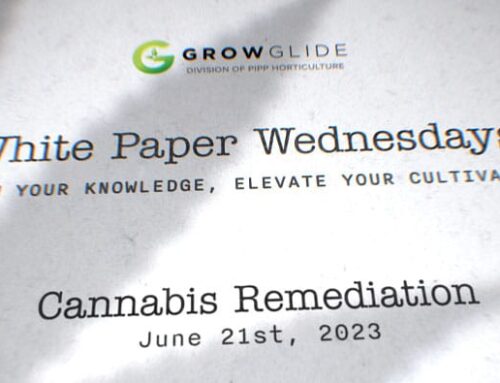
Unveiling the Effects of Light Intensity on Cannabis Yield, Potency, and Photosynthesis in Indoor Cultivation
Introduction
The rapidly expanding cannabis industry has led to a surge in research aimed at optimizing the growth and production of this versatile plant. One crucial aspect of cannabis cultivation, particularly in indoor environments, is the impact of light intensity on yield, leaf photosynthesis, phenotypic expression, bag appeal, customer experience and ultimately price per pound. A groundbreaking study titled “Cannabis Yield, Potency, and Leaf Photosynthesis Respond Differently to Increasing Light Levels in an Indoor Environment,” sheds light on the complex relationship between the relationship between your vertical racking solution, lighting choice and cannabis plant health. In this blog post, we’ll take a deep dive into the findings of this study and explore the implications for cannabis growers seeking to maximize their crop’s productivity and optimize the technology and tools available to future-proof their business.
Understanding the Science of Light
Light is one of the most important factors in cannabis cultivation, but it doesn’t exist in a vacuum. Its intensity and effectiveness is influenced by other cardinal parameters of plant growth and facility design choices like tier to tier spacing. As you know light provides energy for photosynthesis, the process by which plants convert light energy into chemical energy to produce food. Photosynthesis is essential for plant growth but the amount of light that plants receive has a direct impact on their growth and development and is determined by the distance a plant is from the lighting sources.
Cannabis plants require a specific type of light to grow, which is known as photosynthetically active radiation (PAR). PAR is the spectrum of light that plants use for photosynthesis, and historically includes wavelengths between 400 and 700 nanometers (nm). Recent studies have challenged this notion by measuring the impact of NIR,FIR and UV in combination with PAR. However we are here to talk about the impact of usable light at the plant level as we know it and that is measured in PPFD or Photosynthetic Photon Flux Density. PPFD is greatly impacted by tier spacing in vertical cultivation environments and the combined value proposition of lighting and racking should be understood during the design phase.
Key Findings of the Study
The study aimed to assess the impact of varying light intensities on cannabis yield, potency, and leaf photosynthesis in an indoor environment. The researchers exposed cannabis plants to different light levels and carefully analyzed the resulting changes in yield, cannabinoid content, and photosynthetic rates. The key findings of the study can be summarized as follows:
- Yield: The researchers found that cannabis yield increased as light intensity increased. This suggests that higher light levels can contribute to improved growth and productivity of cannabis plants in indoor environments. The relationship between light intensity and yield was found to be linear, indicating a proportional increase in yield with increased light levels assuming all of the 10 cardinal parameters of plant growth are managed relative to leaf temperature and PPFD.
- Potency: The potency of the cannabis plants varied across different light intensities. Some light levels resulted in a higher THC content, while others led to an increase in CBD levels and production of specific terpenes. The relationship between light intensity and potency was not linear, indicating that optimizing light conditions for potency is a complex process. This complexity may be due to the fact that various cannabinoids have different biosynthetic pathways and can be influenced differently by environmental conditions and that the impact of spectrum is cultivar specific.
- Leaf Photosynthesis: The study found that the rate of photosynthesis in cannabis leaves increased with light intensity up to a certain point. Beyond that point, the rate of photosynthesis began to decline, which could be due to factors such as photorespiration or photoinhibition and inability to effectively manage airflow, CO2 delivery or maintain desired temperature and humidity setpoints. These findings suggest that there is an optimal light intensity range for maximizing photosynthesis in cannabis plants but it will be connected to airflow, CO2, temperature, humidity and other factors that influence cultivar vitality.
Effects of Light Distance on Cannabis Plants
- The distance between the light source and cannabis plants can significantly impact plant health, growth, and yield and can be a major limiting factor in production. Light intensity decreases with increasing distance from the source, so proper light distance management and tier to tier spacing relative to your vertical racking solution is crucial in ensuring that plants receive adequate light for photosynthesis and development.
- Light distribution and uniformity: Maintaining an appropriate distance between the light source and plants helps ensure even light distribution across the plant canopy. This is essential for consistent growth and maximizing the efficiency of your photonic energy source, as uneven light distribution can lead to uneven plant development and yield and wasted energy.
- Light intensity: The distance between the light source and plants can influence the intensity of light received by the plants. Insufficient light intensity can result in reduced photosynthesis, slower plant growth, reduced production of secondary metabolites and create pathogen vectors. Also excessive light intensity can cause light burn, photobleaching, photoinhibition, negatively impacting transpiration, plant health and yield.
- Temperature: Light distance can also impact the temperature experienced by plants, as lights emit heat and impact leaf temperature. Maintaining an appropriate distance will homogenize leaf conditions and allow savvy cultivators to use VPD effectively. This allows for the refinement of SOPs, consistent results and appropriate action plans that reduce risk and increase performance.
Light and Cannabis Yields
Light intensity (PPFD) and duration (DLI) are two of the most important factors that affect cannabis yield and they are impacted by the racking solution you invest in. When cannabis plants receive more light, they produce more energy through photosynthesis, which leads to increased growth and yield.
However, it’s not just about providing more light; the distance between the light source and the plants also plays a crucial role in cannabis yield and light intensity measure as PPFD. When the light source is too far away from the plants, the intensity of light reaching the leaves decreases, plants stretch, become weak and this reduction in plant vitality will result in lower yields and have a negative impact on KPIs that drive business decisions.
On the other hand, when the light source is too close to the plants, it can cause heat stress, make VPD impossible to control, cause phototoxicity and photo belching and reduce the medical efficacy and recreational experience for the end user.. Therefore, it’s important to find the optimal distance between the light source to optimize phenotypic expression, the production of secondary metabolites and drive overall operational efficiency metrics.
The Importance of Proper Tier-to-Tier Distances in Multi-Tier Vertical Cultivation Systems
In multi-tier vertical cultivation systems, managing the distance between light sources and plants, as well as the distance between tiers, is crucial. Proper tier-to-tier distances help ensure that each tier receives adequate light, optimizes light crossover and provides room for airflow that allows for convective cooling to occur. Some factors to consider when determining the appropriate tier-to-tier distances include:
- Light type and intensity: Different types of lights have varying wattages, PPF and recommended distances from the plant canopy. Growers should consider the specific light requirements of their plants and the characteristics of their lighting systems when determining tier-to-tier distances.
- Plant size and growth stage: The size and growth stage of cannabis plants can influence the required light distance and intensity. Smaller plants or plants in the vegetative stage may require closer light distances, while larger plants or plants in the flowering stage may need increased spacing to prevent overcrowding or light burn. Also light intensity combined with airflow and advanced crop steering techniques can influence root growth, stem diameter, internodal spacing, plant stretch and even trigger senescence.
- Temperature and airflow: Proper tier-to-tier distances can help maintain optimal temperatures and airflow throughout the cultivation space by facilitating whole air exchanges, preventing anaerobic spaces and mitigating microclimates. This is essential for preventing heat stress, promoting efficient gas exchange, and minimizing the risk of mold and mildew.
Implications for Cannabis Growers
The findings of this study have significant implications for optimizing cannabis cultivation in indoor environments and building facilities that can achieve operational efficiency despite choice of cultivar. By better understanding the effects of light intensity on yield, potency, and photosynthesis, growers can develop strategies to maximize plant productivity and secondary metabolite production. Here are some practical applications of the study’s findings for cannabis growers:
- Optimizing Yield: Growers can adjust light levels to achieve a balance between maximizing yield and minimizing energy consumption leading to operation efficiency. This involves granular data collection that ties the impacts of environmental control and PPFD per stage of growth to production and tracks its thorough price per pound and profitability over time.
- Tailoring Phenotypic expression: Growers seeking to optimize the THC, bag appeal, color, reduce foxtailing, or manage morphology of their plants can experiment with different light levels to determine the optimal conditions for maximizing the desired results. This may involve adjusting light intensity, managing plant distance from the light, spectrum control, or photoperiod to influence biosynthesis and drive the KPIs and metrics each facility uses to determine business success.
- Maximizing Photosynthesis: To optimize photosynthesis and promote healthy plant growth, growers should aim for the optimal PPFD relative to cultivar and stage of growth. Most serious cultivators shoot for 600-800 PPFD in the vegetative stage and 1000-1200 PPFD in the flower stage. This can vary dramatically as some cultivators go as low as 400 PPFD in veg and as high as 1400 PPFD in flower. One item they have in common is that in order to optimize a cannabis plant’s metabolic rate and have her utilize the most energy, exchange the most gas, drink and eat at the fastest rate…the science has shown us that a leaf temperature between 78-82F is optimal. It is true that coller leaf temperatures can be targeted to prevent stretch, impact transpiration, signal anthocyanin production and much more but these crop steering tactics are a delicate balance of risk and reward and should only be done at the commercial level if the outcomes are desirable. One of the biggest limiting factors inhibiting a cultivators ability to adjust PPFD during growth is tier to tier spacing. Too much space and lighting solution and plants will underperform while too little space forces plants to grow into the light and become undesirable.
- Comprehensive Cultivation Strategies: While the study highlights the importance of light intensity in cannabis cultivation, it is crucial to remember that other factors, such as temperature, humidity, and nutrient availability, drainage, airflow, and cultural practices also play a role in plant growth and development. Growers should adopt a holistic approach to cannabis cultivation, taking into account all relevant factors to optimize yield, potency, and overall plant health. It is important for cultivators and owners to consider how they use the tools and technology they purchase so they get the most from every investment.
Challenges and Future Research Directions
Although the study provides valuable insights into the effects of light intensity on cannabis yield, potency, and photosynthesis, there are still many unanswered questions and challenges in this area of research. Future studies could explore the following aspects of cannabis cultivation:
- Light Spectrum: The effects of different light spectra on cannabis growth, yield, and potency remain an area of active research. Understanding how specific wavelengths of light influence plant development and cannabinoid biosynthesis could enable growers to tailor lighting conditions more precisely to optimize desired outcomes.
- Plant Genetics: The relationship between light intensity and cannabis plant response is influenced by the plant’s genetic makeup. Remember that by definition phenotypic expression is 50% genetics and 50% environmental influence. Future research could investigate how different cannabis strains or cultivars respond to varying light levels, airflow velocities, drybacks and other cultivation strategies providing valuable information for growers seeking to optimize specific cultivars.
- Interaction of Environmental Factors: The study focused on light intensity, but it is essential to consider how other environmental factors interact with light levels to influence cannabis growth, yield, and potency. Future research could explore these interactions to provide a more comprehensive understanding of the factors affecting cannabis cultivation in indoor environments and drive more informed decisions regarding airflow, dehumidification, PPFD and tier spacing.
Conclusion
The study sheds light on the complex relationship between light intensity, distance between tiers and operating a successful cannabis cultivation facility. The findings have important implications for cannabis cultivation businesses who want to make the most informed decisions possible regarding the allocation of resources and use of the tools and technology available to the cannabis community. By understanding the effects of light intensity, how to measure intensity and how to determine its impact on these key aspects of cannabis production, cultivators can develop more informed strategies to optimize their cultivation practices and future proof their businesses.
As the cannabis industry continues to grow, research like this plays a vital role in advancing our understanding of the factors affecting cannabis cultivation and production. By embracing these findings, testing them in real world settings and continually refining cultivation practices, cultivators can contribute to the ongoing development of the cannabis industry and ensure the highest quality products for consumers.












